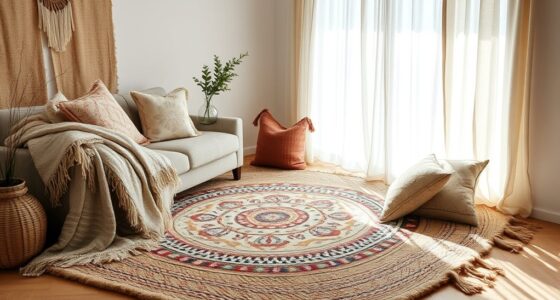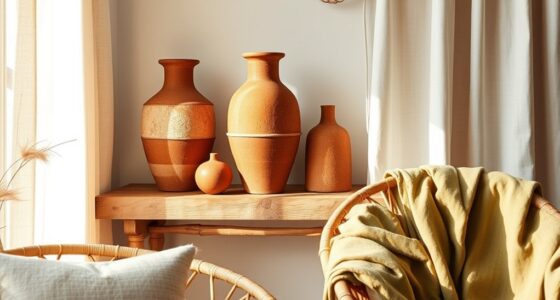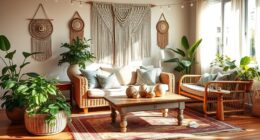To incorporate sustainable textiles like linen and hemp into your boho interiors, focus on choosing fibers that are eco-friendly, durable, and naturally beautiful. Natural dyes enhance their earthy tones and unique textures, adding depth to your decor. Look for certified organic materials and natural dye techniques to guarantee genuine sustainability. These textiles not only support eco-conscious living but also bring warmth, character, and authenticity to your space. Keep exploring how these elements can transform your boho style seamlessly.
Key Takeaways
- Choose natural fibers like linen and hemp sourced from certified sustainable and organic suppliers to ensure eco-friendly material use.
- Incorporate textiles dyed with natural, plant-based dyes to add authentic, subtle hues and enhance boho aesthetic.
- Use textured, hand-dyed fabrics to create layered, tactile decor elements that add depth and character to your space.
- Prioritize durable, high-quality fibers that age gracefully, preserving the natural, relaxed vibe of boho interiors over time.
- Combine eco-conscious textiles with other sustainable decor pieces to promote an authentic, environmentally responsible boho lifestyle.

Sustainable textiles have become a key element in creating authentic and eco-friendly boho interiors. When you focus on natural fiber sourcing, you’re choosing materials like linen and hemp that are renewable, biodegradable, and have a minimal environmental footprint. These fibers are often grown with fewer pesticides and chemicals, making them a healthier choice for the planet and for your indoor environment. By selecting textiles made from natural fibers, you not only embrace the relaxed, earthy vibe of boho style but also support sustainable farming practices. This approach guarantees that your decor contributes to a more responsible and conscious lifestyle.
Choosing natural fibers like linen and hemp supports sustainable, eco-friendly boho interiors with a relaxed, earthy vibe.
In addition to choosing the right fibers, paying attention to eco friendly dye techniques can enhance the sustainability of your textiles. Conventional dyeing methods often involve toxic chemicals and large amounts of water, which can harm ecosystems. Opting for eco-friendly dye techniques means you’ll be using natural dyes derived from plants, roots, and minerals, reducing chemical pollution. These dyes are gentle on the environment and often produce rich, subtle hues that beautifully complement boho interiors. When you incorporate textiles dyed with eco-friendly methods, you elevate the authenticity of your space and demonstrate a commitment to environmental responsibility.
In practice, sourcing textiles with natural fiber sourcing is straightforward. Look for brands that prioritize organic and sustainable fibers, and check labels for certifications like GOTS (Global Organic Textile Standard). These certifications ensure that the fibers are grown and processed with environmentally friendly practices. When shopping for linen or hemp, consider their durability and texture, which add to the layered, tactile feel characteristic of boho decor. Incorporating these textiles into your space—through curtains, cushions, or throws—creates a cozy, inviting atmosphere that aligns with your eco-conscious values.
Meanwhile, choosing textiles dyed with eco friendly dye techniques adds depth and uniqueness to your interiors. You can often find hand-dyed or naturally colored fabrics that showcase subtle variations in tone, enhancing the layered aesthetic of boho style. These textiles not only look beautiful but also tell a story of sustainability and craftsmanship. Whether you’re creating a feature wall or selecting accent pieces, integrating naturally dyed textiles underscores your commitment to eco-friendly interior design.
By understanding the durability and texture of these fibers, you can select textiles that will age gracefully and maintain their beauty over time. Together, natural fiber sourcing and eco friendly dye techniques allow you to craft a space that’s both stylish and sustainable. They help you create a boho interior that’s authentic, environmentally responsible, and filled with textured, organic elements. When you choose these textiles, you’re making a conscious decision that benefits the planet while adding warmth, character, and a genuine bohemian spirit to your home.
Frequently Asked Questions
How Do Linen and Hemp Textiles Compare in Durability?
Linen and hemp textiles both offer impressive durability, but hemp tends to be more resilient due to its dense fiber texture, making it ideal for high-traffic areas. Linen, while slightly softer and more breathable, still provides good longevity. Both fibers often carry eco-friendly certification, ensuring sustainable sourcing. You’ll find hemp’s toughness perfect for long-lasting furnishings, while linen’s texture adds a refined touch to your boho interiors.
Are Sustainable Textiles More Expensive Than Conventional Options?
Sure, sustainable textiles often seem like the luxury yacht of home decor—costly at first glance. But, when you compare the cost comparison over time, they usually save you money and the environment. Linen and hemp have a lower environmental impact, making them worth the investment. So, while they may seem pricier initially, your wallet—and planet—will thank you for choosing sustainability over short-term savings.
How Do Linen and Hemp Fabrics Age Over Time?
Linen and hemp fabrics age beautifully over time, developing unique aging characteristics. As they age, you’ll notice a softening of the fibers, which adds to their charm. Color fading may occur, giving the textiles a more vintage, lived-in look that enhances your boho style. These fabrics tend to become more comfortable and appealing, making them a sustainable choice that gains character and warmth as they age.
Can Sustainable Textiles Be Blended With Synthetic Fibers?
Sure, you can blend sustainable textiles with synthetic fibers—who wouldn’t want a little eco-friendly chaos? A synthetic blend with linen or hemp creates durability while using eco-friendly dyes, making your boho space both stylish and responsible. Just remember, mixing the old with the new can be a delicate dance, but it’s worth it for that unique, sustainable vibe you’re aiming for.
What Maintenance Practices Extend the Lifespan of Linen and Hemp?
To extend the lifespan of linen and hemp, you should follow natural fiber care practices, like gentle washing in cold water and avoiding harsh detergents. Use eco-friendly dyes to prevent color fading. Regularly air out your textiles to prevent mold and keep them looking fresh. When ironing, use low heat, and store these fibers in a cool, dry place. Proper maintenance keeps your sustainable textiles beautiful and durable for years.
Conclusion
By choosing sustainable textiles like linen and hemp, you not only enhance your boho interiors with natural beauty but also make eco-friendly choices. These materials bring warmth, texture, and sustainability into your space, reflecting your conscious lifestyle. Isn’t it rewarding to create a home that’s stylish and kind to the planet? Embrace these eco-chic options and transform your interiors into a sanctuary that celebrates both nature and your unique style. The future of boho is sustainable—are you ready to be part of it?









